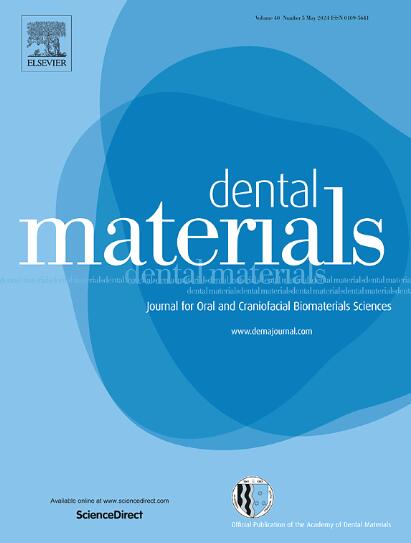具有自修复潜力的3d打印义齿基托树脂复合材料的开发与表征。
IF 4.6
1区 医学
Q1 DENTISTRY, ORAL SURGERY & MEDICINE
引用次数: 0
摘要
目的:研制并表征含有自修复聚脲甲醛(PUF)微胶囊(TEGDMA为核心愈合剂)的3d打印义齿树脂复合材料,以阻止微裂纹的形成,提高3d打印义齿的机械耐久性。方法:采用水包油乳化法制备以TEGDMA为核心材料的PUF微胶囊,并对其尺寸、表面形貌和热稳定性进行表征。打印合成PUF含量分别为0、5、15和25 wt%的3d打印义齿基托树脂,并通过转化程度、表面形貌、形貌、表面硬度、抗弯强度、断裂韧性、自愈效率,以及通过树脂基质内破裂的PUF微胶囊原位释放罗丹明B标记的愈合剂来观察微裂纹的自愈事件的荧光显微显示来评估。结果:与对照组相比,经PUF微胶囊改性的3d打印义齿基托复合材料的转化度、表面硬度和抗弯强度均略有下降。结果表明,微胶囊含量的显著增加(p ≤ 0.05)提高了断裂韧性和自愈效率。实验组的HPLC结果分析显示,愈合剂随时间的释放具有控释特征,在第7天达到最大释放。显微可视化结果显示罗丹明b标记的愈合剂在裂纹面上的成功包封和有意触发释放。意义:基于微胶囊的含量(wt%), PUF微胶囊改性的3d打印义齿基托树脂复合材料具有显著的微裂纹自愈潜力和断裂韧性增强。本文章由计算机程序翻译,如有差异,请以英文原文为准。
Development and characterization of 3D-printed denture base resin composites having self-healing potential
Objective
This study aims to develop and characterize 3D-printed denture resin composites containing self-healing polyurea formaldehyde (PUF) microcapsules (TEGDMA as the core healing agent) for arresting microcracks formation and enhancing the mechanical durability of 3D-printed dentures.
Methods
The PUF microcapsules containing TEGDMA as core material were synthesized in oil-in-water emulsion and characterized for size, surface morphology and thermal stability. 3D-printed denture base resin with 0, 5, 15, and 25 wt% content of the synthesized PUF were printed and evaluated by degree of conversion, surface morphology, topography, surface hardness, flexural strength, fracture toughness, self-healing efficiency, and fluorescent microscopic visualization of the microcracks’ self-healing event through the in-situ release of rhodamine B labelled healing agent from ruptured PUF microcapsules inside the resin matrices.
Results
As compared to the control, a slight decrease was observed in the degree of conversion, surface hardness and flexural strength of the 3D-printed denture base composite modified with the PUF microcapsules. Results demonstrated that an increase in the microcapsule content significantly (p ≤ 0.05) enhances the fracture toughness and self-healing efficiency. The HPLC results analysis of the experimental groups demonstrated a controlled release profile of healing agent over time with the maximum release on day 7. The microscopic visualization findings demonstrated the successful encapsulation and intentional triggered release of the rhodamine B. labelled healing agent in the crack plane.
Significance
The 3D-printed denture base resin composites modified with the PUF microcapsules showed a significant potential for microcrack self-healing and enhanced fracture toughness based on the content (wt%) of microcapsules.
求助全文
通过发布文献求助,成功后即可免费获取论文全文。
去求助
来源期刊

Dental Materials
工程技术-材料科学:生物材料
CiteScore
9.80
自引率
10.00%
发文量
290
审稿时长
67 days
期刊介绍:
Dental Materials publishes original research, review articles, and short communications.
Academy of Dental Materials members click here to register for free access to Dental Materials online.
The principal aim of Dental Materials is to promote rapid communication of scientific information between academia, industry, and the dental practitioner. Original Manuscripts on clinical and laboratory research of basic and applied character which focus on the properties or performance of dental materials or the reaction of host tissues to materials are given priority publication. Other acceptable topics include application technology in clinical dentistry and dental laboratory technology.
Comprehensive reviews and editorial commentaries on pertinent subjects will be considered.
 求助内容:
求助内容: 应助结果提醒方式:
应助结果提醒方式:


